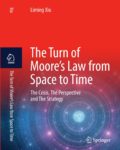 “It’s time for the big ship of Moore’s Law to make a turn from space to time” is a nonconformist message that surprised me when I read the book “The Turn of Moore’s Law from Space to Time” by Mr. Liming Xiu.
“It’s time for the big ship of Moore’s Law to make a turn from space to time” is a nonconformist message that surprised me when I read the book “The Turn of Moore’s Law from Space to Time” by Mr. Liming Xiu.
As a forty-year veteran and as an author of several books on the semiconductor industry myself, I am quite familiar with all contemporary debates on Moore’s Law. In this book, Moore’s Law is investigated from the two fundamental constituents of our universe: space and time. For the first time, microelectronics is inspected at its root for a potential detour to circumvent the space crisis that this field is currently facing.
Moore’s Law 1.0 is about space, Moore’s Law 2.0 focuses on time. The takeaways from the book are: 1) Microelectronics is currently facing a crisis caused by over-exploiting space; 2) A new avenue is along the dimension of time; 3) In the new battle, circuit professionals will take the lead.
Starting around the 2000s, people were aware of an alarming problem with Moore’s Law. Various proposals have been suggested to save its life. Two well-known genres are More Than Moore and Beyond Moore; each of them has numerous variants.
However, no one has pointed out that the root-of-problem of this crisis is space-over-exploitation. No matter how sophisticated our engineering skills become, we cannot keep making the basic switch-for-information (i.e., transistor) ever smaller. We must stop somewhere along this path. Semiconductor insiders know this, however, few are willing to make the call of jam-on-the-brakes for various reasons. The most compelling one is financial detriment since heavy investment has already been placed in this direction. Like the child in “The Emperor’s New Clothes”, this book blurts out that this route will meet a dead-end. The author asserts that now is the time for a major overhaul. The new route is along the direction of time, the only rival and equal weight to space.
To exploit time, this book further advocates two interesting ideas of “adopting
nonuniform-flow-of-time” and “using time as the medium for information-coding (switching the role of voltage and time)”. I have seen people using fixed-frequency clock to drive electronics from the outset of microelectronics. This naturally leads to uniform-flow-of-time inside the electronic world. But, as Xiu asked, is this efficient? Can the electronic world employ nonuniform-flow-of-time as the biological world does?
He argues that uniform-flow-of-time is just a dogma for the convenience of our engineering. It does not have to be that way if there is a need to change it. The second idea of explicitly using time as message is even more eccentric. Voltage has always been used as the medium for representing information, either in analog or digital style. As transistor becomes smaller, it switches faster. However, it tends to be much noisier. Further, the supply voltage is made ever lower as process progresses. All those factors are unfavorable to the continuous use of voltage as message carrier.
On the other hand, the ever-faster-switching transistor offers us an opportunity of using rate-of-switching as an alternative for expressing our thought. This idea, although not being practical yet as admitted by the author, also sounds legitimate to me.
An exciting aspect of this book is the author’s investigation of microelectronics through the lens of scientific revolution. Employing Thomas Kuhn’s technique of examining abnormal and crisis in the development of science, the author scrutinizes the semiconductor industry using a similar tactics albeit microelectronics is not a branch of science but engineering. It recognizes the current space-related problem in microelectronics as a crisis, like the ones we have seen in the evolution of a pure science (e.g., physics). Crisis leads to revolution. Following this logic, Xiu describes the past activities of microelectronics as occurring inside a Space- Dominant Paradigm. A paradigm shift is called for to overcome the crisis. The new one is defined as Time-Oriented Paradigm. I feel that this proposition is thought-provoking.
As history taught us, new thinking often meets with resistance at its debuts.
Recognizing the difficulty in change-of-mindset, a brief review of the semiconductor industry is presented in chapter two, an in-depth discussion on several key notions (space, time, change and motion) is carried out in chapter three. In section 4.1, a discussion of philosophical nature is included to persuade reader that the turn from space to time is requisite and is the only worthwhile alternative. All those efforts are helpful in making the process of change-of-mindset easier and smoother.
The author of this book has an unusual sophisticated approach (as you will see in the preface). He is an industry scholar. It is unique for a circuit design professional to have such a deep academic consciousness on foundational issues. This scholastic perception, on top of the battle-hardened industry experience, enables him to view the industry from an idiosyncratic perspective and create a distinctive book like this one. Overall, this is an inspiring book. The thesis is well supported by the tactics used throughout the book: learning from history, reasoning through philosophical contemplation, describing tools for materialization, and demonstrating plausibility through real cases. This is a book of vision. It has something for everyone involved in the semiconductor industry, absolutely.
The Turn of Moore’s Law from Space to Time — The Crisis, The Perspective
and The Strategy Springer, 2022, ISBN-10: 9811690642, ISBN-13: 978-9811690648 https://link.springer.com/book/10.1007/978-981-16-9065-5
Also Read:
Calibre, Google and AMD Talk about Surge Compute at #59DAC
Future Semiconductor Technology Innovations
Solve Embedded Development Challenges With IP-Centric Planning
Share this post via:








Quantum Computing Technologies and Challenges